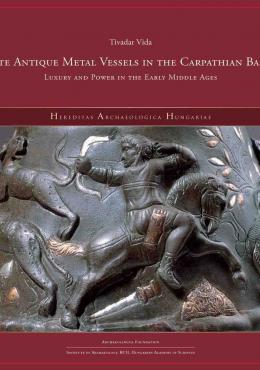Late Antique Metal Vessels in the Carpathian Basin

Late Antique Metal Vessels in the Carpathian Basin
| 10 066 Ft |
| Price |
Hereditas Archaeologiae Hungaricae
Budapest, Archaeolingua, 2016
Puhakötés | Paper book
143 oldal, színes és fekete-fehér illusztrációkkal | 143 pages with colored and grayscale images
ISBN 978 963 9911 81 9
Ez a könyv magyarul is elérhető | This book is also available in Hungarian
Table of contents // Tartalomjegyzék
Description
The magnificent gold and silver vessels that reached the Barbarian elites of the Migration period either as diplomatic gifts or as war booty, as part of annual subsidies or through trade, attest to the many forms of cultural exchanges between the late antique civilisation of the Mediterranean and the tribal kingdoms emerging on its fringes. These resplendent silver and gold vessels were prized possessions of elite households, whose display enhanced the splendour of community feasts and ceremonies. As expensive diplomatic gifs, precious metal vessels played an important role in maintaining and cementing amicable relations and alliances between the late antique states and the Barbarian kingdoms. The elegant gold and silver vessels bore witness to the prosperity and “good life” of the late antique aristocracy, while their graceful form and delicate ornamentation were designed to reflect the erudition and cultural values of their owners. These masterpieces of late antique art retained their role as status symbols in their new cultural milieu too, and they were sometimes circulated as part of the gift exchanges between Barbarian elites or between a Barbarian king and his nobles. The more humble copper-alloy vessels used in daily life can usually be associated with the middle classes and reflect the appeal of the late antique aristocracy’s lifestyle to a broader circle as well as the desire to emulate their table customs and to acquire at least copies of their tableware. Late antique and early Byzantine metal vessels were mediums of social display not only during their owners’ lifetimes, but also after their death through the deposition of these impressive items in burials.
| |
|
|
1067 Budapest, Teréz krt. 13. |
|
|
|
|
About us
The Archaeolingua Foundation and Publisher is involved in publishing series and standalone publications in the disciplines of archaeology, linguistics, historic sciences and heritage protection for over 25 years.
Learn more
Publishing
We publish both as standalone editions and as a volume of a professional series.
Learn more
Contact us
Archaeolingua Foundation

